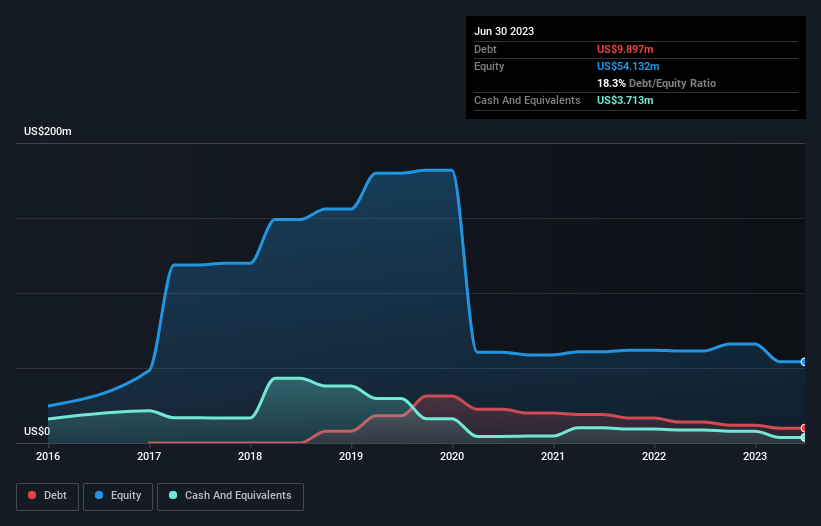
David Iben put it well when he said, 'Volatility is not a risk we care about. What we care about is avoiding the permanent loss of capital.' So it might be obvious that you need to consider debt, when you think about how risky any given stock is, because too much debt can sink a company. We can see that Australis Oil & Gas Limited (ASX:ATS) does use debt in its business. But is this debt a concern to shareholders?
Why Does Debt Bring Risk?
Debt assists a business until the business has trouble paying it off, either with new capital or with free cash flow. If things get really bad, the lenders can take control of the business. While that is not too common, we often do see indebted companies permanently diluting shareholders because lenders force them to raise capital at a distressed price. By replacing dilution, though, debt can be an extremely good tool for businesses that need capital to invest in growth at high rates of return. The first step when considering a company's debt levels is to consider its cash and debt together.
See our latest analysis for Australis Oil & Gas
How Much Debt Does Australis Oil & Gas Carry?
As you can see below, Australis Oil & Gas had US$9.90m of debt at June 2023, down from US$14.0m a year prior. However, it does have US$3.71m in cash offsetting this, leading to net debt of about US$6.18m.

How Healthy Is Australis Oil & Gas' Balance Sheet?
We can see from the most recent balance sheet that Australis Oil & Gas had liabilities of US$10.4m falling due within a year, and liabilities of US$8.89m due beyond that. Offsetting these obligations, it had cash of US$3.71m as well as receivables valued at US$3.19m due within 12 months. So its liabilities outweigh the sum of its cash and (near-term) receivables by US$12.4m.
Australis Oil & Gas has a market capitalization of US$22.0m, so it could very likely raise cash to ameliorate its balance sheet, if the need arose. But it's clear that we should definitely closely examine whether it can manage its debt without dilution. When analysing debt levels, the balance sheet is the obvious place to start. But ultimately the future profitability of the business will decide if Australis Oil & Gas can strengthen its balance sheet over time. So if you're focused on the future you can check out this free report showing analyst profit forecasts.
In the last year Australis Oil & Gas had a loss before interest and tax, and actually shrunk its revenue by 7.9%, to US$23m. That's not what we would hope to see.
Caveat Emptor
Over the last twelve months Australis Oil & Gas produced an earnings before interest and tax (EBIT) loss. Indeed, it lost a very considerable US$12m at the EBIT level. When we look at that and recall the liabilities on its balance sheet, relative to cash, it seems unwise to us for the company to have any debt. Quite frankly we think the balance sheet is far from match-fit, although it could be improved with time. We would feel better if it turned its trailing twelve month loss of US$13m into a profit. So to be blunt we do think it is risky. When analysing debt levels, the balance sheet is the obvious place to start. However, not all investment risk resides within the balance sheet - far from it. For example - Australis Oil & Gas has 4 warning signs we think you should be aware of.
When all is said and done, sometimes its easier to focus on companies that don't even need debt. Readers can access a list of growth stocks with zero net debt 100% free, right now.
New: Manage All Your Stock Portfolios in One Place
We've created the ultimate portfolio companion for stock investors, and it's free.
• Connect an unlimited number of Portfolios and see your total in one currency
• Be alerted to new Warning Signs or Risks via email or mobile
• Track the Fair Value of your stocks
Have feedback on this article? Concerned about the content? Get in touch with us directly. Alternatively, email editorial-team (at) simplywallst.com.
This article by Simply Wall St is general in nature. We provide commentary based on historical data and analyst forecasts only using an unbiased methodology and our articles are not intended to be financial advice. It does not constitute a recommendation to buy or sell any stock, and does not take account of your objectives, or your financial situation. We aim to bring you long-term focused analysis driven by fundamental data. Note that our analysis may not factor in the latest price-sensitive company announcements or qualitative material. Simply Wall St has no position in any stocks mentioned.
About ASX:ATS
Australis Oil & Gas
An upstream oil and gas company, engages in the exploration, development, and production of oil and gas assets in the United States of America.
Adequate balance sheet and slightly overvalued.
Similar Companies
Market Insights
Community Narratives




